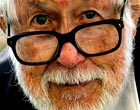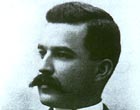Even as a child, Robert Earle Lopez knew his family tree was deeply rooted in the soil
of Los Angeles. He'd heard stories:
In 1826, when the City of Angels was a mere struggling pueblo, Lopez's great-great-great
grandfather, Claudio Lopez, was the mayor. Claudio's son, Esteban Lopez, owned much of the
land that is now Boyle Heights. Esteban's son, Francisco "Chico" Lopez, made a
fortune as a cattle rancher; and Chico's son Frank -- Robert Earle Lopez's grandfather--
became one of the city's first auditors.
In 1838, Marie Rita Valdez, another ancestor, was granted the deed for what is now Beverly
Hills. Francisco Lopez, a distant cousin, discovered gold while digging for wild onions at
the foot of an oak tree in Placerita Canyon, six years before the 1848 find at Sutter's
Mill sparked the California gold rush.
Robert Earle Lopez grew up believing that his Spanish pedigree was strictly upper crust,
grounded in Castilian nobility, as his aunt used to say. But a clearer picture emerged
years later, after Los Angeles' bicentennial celebrations in 1981.
That's when Lopez, digging deeper into his family's history, discovered that one of his
great-great-great-great grandfathers was Luis Manuel Quintero, one of the original
settlers -- or pobladores -- who founded El Pueblo de La Reina de Los Angeles on Sept. 4,
1781.
Quintero was the son of a black slave. Indeed, Lopez learned, more than half of the city's
original settlers traced all or part of their heritage to Africa.
The fact that his forebear was not a Spanish blueblood came as a surprise. But Lopez
quickly embraced the lineage that connects him to the original 11 families whose 44
members -- a group of poor farmers of African, European and Indian extraction -- laid the
foundation for the second largest city in the United States.
"I come from one of the colored guys," the 86-year-old boasts. "I guess by
the time it got to me, there wasn't much color anymore. Still, I'm proud to say I come
from that ragtag group that founded Los Angeles."
Not everyone connected to the original 44 shares his view.
Robert Lopez likes to say that his mother missed the chance to cast a ballot in the first
presidential election in which women had the right to vote. She was in the hospital giving
birth to him on Nov. 2, 1920.
By then, the Lopez family's vast holdings were gone and he was raised speaking English,
rather than Spanish. His mother's ancestry was German. Still, the family name carried a
strong sense of the past, something that, growing up in Boyle Heights and later in a
Mid-City neighborhood, he was never allowed to forget.
Spanish soldiers from the Lopez clan could be traced back to the 18th century, he was
told. He heard the family stories of Chico Lopez's long cattle drive to feed gold miners
in Northern California. He was still a boy when the local civic club invited the family to
an event honoring the Placerita Canyon site where gold was first discovered. And his aunt
insisted they all came from Northern Spain.
Today Lopez knows better. "The only way I could come from Spain would be on a
747," he jokes.
Lopez's childhood was cut short by hardships: the Great Depression and the death of his
father. He did a stint in the Army Air Corps, became part owner of an electrical
instrument company and got married. He sold the business in the early 1960s and retired at
43. "I took the money and ran," he said. He took up sailing and made three trips
to Hawaii before setting his sights on investigating his family's past.
At the time, the city was in the midst of its bicentennial celebrations. Some 200
descendants of the pueblo founders marched from the San Gabriel Mission to Olvera Street,
where the names of the original families and their ethnicities were inscribed on a plaque
in El Pueblo de Los Angeles Historic Monument plaza.
The march is now an annual event. The fact that Los Angeles, one of the most culturally
diverse cities in the world, stemmed from a multiethnic pueblo is often touted as evidence
that the city has remained true to its roots.
"Its cosmopolitan population has been one of the hallmarks of Los Angeles since its
founding," said Doyce B. Nunis Jr., a professor emeritus of history at USC who headed
a bicentennial committee and wrote a book in 2005 on the founding of Los Angeles.
The late Marie E. Northrop, a genealogist who wrote three volumes on Spanish Mexican
families of early California, was credited with pulling together the descendants to
complete the march and later, she and her husband Joe Northrop, who was a descendant,
became the driving force behind Los Pobladores 200, an organization of original
descendants of the first settlers of Los Angeles.
Lopez, who missed the bicentennial celebration, wanted in. But he wasn't certain about the
connection between his forefathers and those who founded the city. None of the original
settlers was named Lopez. With help from Northrop, he found the answer. His kinship with
the original group of settlers did not come by way of his great-grandfathers but through
one of his great-grandmothers.
Chico's mother, Maria Jacinta Valdez, was the key. Her mother, Maria Fabianna Sebastiana
Quintero, was one of the seven daughters of Luis Manuel Quintero and his wife, Maria Petra
Rubio.
With Quintero as his link, Lopez joined Los Pobladores, served as its president and became
the membership chairman, a post he still holds.
Lopez celebrated his ties to Quintero, but others, including some in his own family, were
unable to see beyond his color.
"There are three kinds of descendants," Northrop said in the late 1980s.
"There are those who know and are proud. There are those who don't know and don't
care. And then there are those who know but deny."
Nunis said some descendants were infuriated at the idea of putting the founder's
ethnicities next to the names on the plaque honoring the settlement.
"Nobody wanted to put the races on the plaque," Nunis said. "No! No! No!
They didn't, but we had the evidence. I put my foot down, and that was it."
Today, 25 years later, race remains a hot-button issue with some members.
"There are a lot of inaccuracies," said Ed Pico, a descendant of Pio Pico, the
last Mexican governor of California, who is considered to have a racially mixed ancestry.
"It's political. 'Half the founders were black or Mexican.' That's not the
case."
Bob Smith, a member of Los Pobladores who traces his ancestry to the early British Empire,
agrees that the founders were of mixed heritage, but disagrees with Northrop's accounting.
For example, he says that Quintero is not black or Negro as he is listed on the plaque,
but the product of an Indian mother and a Spanish and Moorish father.
Paul V. Guzman, a past president of Los Pobladores 200 who traces his roots to several
founding settlers, disagrees.
"He was a Negro; he was black," Guzman said. "The Spanish brought thousands
of slaves from Africa. I don't want to use the word prejudice, but you can't deny the
heritage. We had members in good standing who left because of the question of black blood.
They left and they shouldn't have."
Another bone of contention has been the founders' national origin. Smith has criticized
Mayor Antonio Villaraigosa for making repeated references to the founders as coming from
Mexico, which gained independence from Spain 40 years after the city's founding in 1781.
"He's trying to rewrite history to boost the pride of Mexicans," Smith said.
"California was founded under colonial Spain. But he doesn't like Spain for some
reason."
For more than 55 years, Lopez and his wife Margaret have lived in the same modest house in
Westchester where they raised five children and stored memorabilia stretching over eight
generations: photocopied census books from L.A.'s beginnings as a pueblo of New Spain, a
reprint of a family cattle brand and an array of family pictures from his youngest
grandchildren to a portrait of rancher Chico Lopez.
There's a copper tub once used to make lard from cattle fat and a cast-iron salute cannon
inherited from an Aunt Francisca, who was known for collecting family artifacts.
"She had sticky fingers," Lopez said.
From his house, Lopez said, he can easily check the lineage of almost all potential
applicants for membership in Los Pobladores 200.
"All I need is the name of the grandfather and maybe a great-grandfather. If I can
[trace it back] to 1850, then usually I'm home free," said Lopez, who has seen the
organization dwindle -- largely the result of age and declining interest -- to about 100
members.
Those early settlers of Los Angeles, recruited from various villages in the Sonora and
Sinaloa states of New Spain -- now Mexico -- gathered at the San Gabriel Mission before
walking the last few miles to the settlement where a cornerstone was laid Sept. 4.
"They had to be coerced to come to this outpost of the empire," said Gloria
Lothrop, a retired Cal State Northridge history professor. "They were lured by the
offer of land, tools, seeds and animals."
Quintero, who was born about 1725 in Guadalajara, Jalisco, was the last poblador to sign
up for the expedition.
A tailor by trade and not a farmer, he didn't last long in early Los Angeles. Six months
after founding the pueblo, he, his wife, Maria Petra Rubio, identified as a mulatto, and
children left and became one of the first families in Mission San Buenaventura (Ventura)
and later founding members of the presidio of Santa Barbara, where he died in 1810.
"He made a big splash," said Irene Sepulveda Hastings, current president of Los
Pobladores 200. "I always tease my kids that we get our curly hair from
Quintero."
On one recent day, Lopez was slowed by the pain of arthritis.
"I don't know," he said. "It seems like I turned 86 and suddenly got
old."
"He's still a live wire," Margaret interjected.
Lopez closed his eyes for a moment.
"He always shuts his eyes when he's trying to remember something," Margaret
explained.
Sitting slightly uncomfortably in a chair nearby, he opened his eyes and reflected on how
much the city has changed. He was a boy when City Hall -- then the tallest building -- was
under construction. Since then Los Angeles has gotten taller and deeper, filled in by
waves of people from around the country and immigrants from around the world.
"There used to be one or two pages of Lopezes in the telephone book, but now you
can't count them," he said.
In many ways, he added, there is a connection to those original families of the past:
"They were all looking for a better life."
john.mitchell@latimes.com
SOURCE: http://www.latimes.com/news/la-me-founders22aug22,0,6216757,full.story?coll=la-tot-topstories


